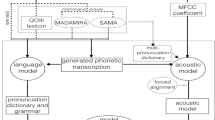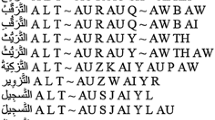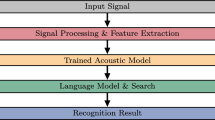Abstract
The aim of this article is to study the Arabic speech processing applications which have introduced the voice communication as a solution for specific situations (non-native speakers, speakers with voice disabilities, learners of Arabic vocabulary, speech recognition or speech synthesis). We present the principal applications of processing the Arabic spoken language accentuating the most challenges preventing obtaining better results. The current paper gives in detail the followed approaches and the applied techniques in the automatic processing applications of spoken Arabic, so it can be a reference study for researchers and developers who deal with this topic.
Access this chapter
Tax calculation will be finalised at checkout
Purchases are for personal use only
Similar content being viewed by others
References
Srivastava, V., Singh, M.: Challenges and considerations with Code-Mixed NLP for Multilingual Societies. arXiv preprint arXiv:2106.07823 (2021)
Ruder, S., Constant, N., Botha, J., Siddhant, A., Firat, O., Fu, J., Johnson, M.: XTREME-R: towards more challenging and nuanced multilingual evaluation. arXiv preprint arXiv:2104.07412 (2021)
Li, X., Gong, H.: Demystify optimization challenges in multilingual transformers. arXiv preprint arXiv:2104.07639 (2021)
Darwish, K., Habash, N., Abbas, M., Al-Khalifa, H., Al-Natsheh, H.T., Bouamor, H., Mubarak, H.: A panoramic survey of natural language processing in the Arab world. Commun. ACM 64(4), 72–81 (2021)
Dressler, W.U., Mattiello, E., Ritt-Benmimoun, V.: Typological impact of morphological richness and priority of pragmatics over semantics in Italian, Arabic, German, and English diminutives.
Elfaik, H.: Combining context-aware embeddings and an attentional deep learning model for Arabic affect analysis on twitter. IEEE Access 9, 111214–111230 (2021)
Kawar, K.: Morphology and syntax in Arabic-speaking adolescents who are deaf and hard of hearing. J. Speech Lang. Hear. Res. 1–16 (2021)
Abd, D.H., Khan, W., Thamer, K.A., Hussain, A.J.: Arabic light stemmer based on ISRI stemmer. In: International Conference on Intelligent Computing, pp. 32–45 (2021)
Arian, A., Rahimi Khoigani, M.: Investigating quranic ambiguity translation strategies in Persian and Chinese: lexical and grammatical ambiguity in focus. Linguist. Res. Holy Quran 10(1), 61–78 (2021)
Ezzini, S., Abualhaija, S., Arora, C., Sabetzadeh, M., Briand, L.C.: MAANA: an automated tool for DoMAin-specific HANdling of ambiguity. In: IEEE/ACM 43rd International Conference on Software Engineering, pp. 188–189 (2021)
Habash, N.: 13 Arabic dialect processing. In: Similar Languages, Varieties, and Dialects: A Computational Perspective, 279 (2021)
Ullah, A., Kui, Z., Ullah, S., Pinglu, C., Khan, S.: Sustainable utilization of financial and institutional resources in reducing income inequality and poverty. Sustainability 13(3), 1038 (2021)
Guellil, I., Saâdane, H., Azouaou, F., Gueni, B., Nouvel, D.: Arabic natural language processing: an overview. J. King Saud University-Comput. Inf. Sci. 33(5), 497–507 (2021)
Guellil, I., Adeel, A., Azouaou, F., Benali, F., Hachani, A.E., Dashtipour, K., Hussain, A.: A semi-supervised approach for sentiment analysis of arab (ic/izi) messages: application to the Algerian dialect. SN Comput. Sci. 2(2), 1–18 (2021)
Talafha, B., Abuammar, A., Al-Ayyoub, M.: ATAR: Attention-based LSTM for Arabizi transliteration. Int. J. Electr. Comput. Eng. (IJECE) 11(3), 2327–2334 (2021)
Eryani, F., Habash, N.: Automatic romanization of arabic bibliographic records. In: 6th Arabic Natural Language Processing Workshop, pp. 213–218 (2021)
Ouisaadane, A., Safi, S.: A comparative study for Arabic speech recognition system in noisy environments. Int. J. Speech Technol. 1–10 (2021)
Al-Anzi, F.S., AbuZeina, D.: Synopsis on Arabic speech recognition. Ain Shams Eng. J. (2021)
Mittal, V., Sharma, R.K.: Deep Learning Approach for Voice Pathology Detection and Classification. Int. J. Healthcare Inf. Syst. Inform. (IJHISI) 16(4), 1–30 (2021)
Harder, B.: Speech language pathology, occupational therapy, and physical therapy student perspectives of an interprofessional education simulation (2021)
Yusof, N., Baharudin, H., Hamzah, M.I., Malek, N.I.A.: Fuzzy Delphi method application in the development of I-Aqran module for Arabic vocabulary consolidation. Ijaz Arabi J. Arabic Learn. 4(2) (2021)
Ali, Z., Saleh, M., Al-Maadeed, S., Abou Elsaud, S., Khalifa, B., AlJa’am, J.M., Massaro, D.: Understand my world: an interactive app for children learning Arabic vocabulary. In: IEEE Global Engineering Education Conference, pp. 1143–1148 (2021)
Farghaly, A., Shaalan, K.: Arabic natural language processing: challenges and solutions. ACM Trans. Asian Lang. Inf. Process. 8(4), 1–22 (2009)
Habash, N.Y.: Introduction to Arabic natural language processing, vol. 3. Morgan & Claypool Publishers (2010)
Alsayadi, H.A., Abdelhamid, A.A., Hegazy, I., Fayed, Z.T.: Arabic speech recognition using end-to-end deep learning. IET Signal Process. (2021)
Zhang, J., Wang, B., Zhang, C., Xiao, Y., Wang, M.Y.: An EEG/EMG/EOG-based multimodal human-machine interface to real-time control of a soft robot hand. Front. Neurorobot. 13, 7 (2019)
Friedrich, M., Peinecke, N., Geister, D.: Human machine interface aspects of the ground control station for unmanned air transport. In: Automated Low-Altitude Air Delivery, pp. 289–301 (2022)
Vacher, M., Lecouteux, B., Portet, F.: Recognition of voice commands by multisource ASR and noise cancellation in a smart home environment. In: 20th European Signal Processing Conference (EUSIPCO), pp. 1663–1667 (2012)
McLaughlin, N., Ming, J., Crookes, D.: Speaker recognition in noisy conditions with limited training data. In: 19th European Signal Processing Conference, pp. 1294–1298 (2011)
Biagetti, G., Crippa, P., Falaschetti, L., Orcioni, S., Turchetti, C.: Speaker identification in noisy conditions using short sequences of speech frames. In: International Conference on Intelligent Decision Technologies, pp. 43–52 (2017)
Ming, J., Hazen, T.J., Glass, J.R., Reynolds, D.A.: Robust speaker recognition in noisy conditions. IEEE Trans. Audio Speech Lang. Process. 15(5), 1711–1723 (2007)
Biagetti, G., Crippa, P., Curzi, A., Orcioni, S., Turchetti, C.: Speaker identification with short sequences of speech frames. ICPRAM (2), pp. 178–185 2015
Deshpande, M.S., Holambe, R.S.: Speaker identification based on robust AM-FM features. In: 2nd International Conference on Emerging Trends in Engineering & Technology, pp. 880–884 (2009)
Ali, A.H., Magdy, M., Alfawzy, M., Ghaly, M., Abbas, H.: Arabic speech synthesis using deep neural networks. In: International Conference on Communications, Signal Processing, and their Applications (ICCSPA), pp. 1–6. IEEE (2021)
Mutawa, A.M.: Machine learning for Arabic text to speech synthesis: a Tacotron approach (2021)
Bettayeb, N., Guerti, M.: Speech synthesis system for the holy quran recitation. Int. Arab J. Inf. Technol. 18(1), 8–15 (2021)
El-Dakhs, D.A.S., Ahmed, M.M.: A variational pragmatic analysis of the speech act of complaint focusing on Alexandrian and Najdi Arabic. J. Pragmat. 181, 120–138 (2021)
Shaalan, K., Talhami, H.: Error analysis and handling in Arabic icall systems. In: Artificial Intelligence and Applications (2006). Citeseer, pp. 109–114
Shaalan, K.F.: An intelligent computer assisted language learning system for Arabic learners. Comput. Assist. Lang. Learn. 18(1–2), 81–109 (2005)
Meftouh, K., Harrat, S., Jamoussi, S., Abbas, M., Smaili, K.: Machine translation experiments on padic: a parallel Arabic dialect corpus. In: Pacific Asia Conference on Language, Information and Computation (2015)
Terbeh, N., Zrigui, M.: Vers la correction automatique de la Parole Arabe. Citala 2014 (2014)
Maraoui, M., Terbeh, N., Zrigui, M.: Arabic discourse analysis based on acoustic, prosodic and phonetic modeling: elocution evaluation, speech classification and pathological speech correction. Int. J. Speech Technol. 1071–1090 (2018)
Terbeh, N., Zrigui, M.: Vocal pathologies detection and mispronounced phonemes identification: case of Arabic continuous speech. In: 10th International Conference on Language Resources and Evaluation (LREC’16), pp. 2108–2113 (2016)
Terbeh, N., Zrigui, M.: Identification of pronunciation defects in spoken Arabic language. In: International Conference of the Pacific Association for Computational Linguistics, pp. 355–365 (2017)
Terbeh, N., Zrigui, M.: A novel approach to identify factor posing pronunciation disorders. In: International Conference on Computational Collective Intelligence, pp. 153–162 (2016)
Terbeh, N., Trigui, A., Maraoui, M., Zrigui, M.: Arabic speech analysis to identify factors posing pronunciation disorders and to assist learners with vocal disabilities. In: 2016 International Conference on Engineering & MIS (ICEMIS), pp. 1–8 (2016)
Terbeh, N., Trigui, A., Maraoui, M., Zrigui, M.: Correction of pathological speeches and assistance to learners with vocal disabilities. Multimedia Tools Appl. 77(14), 17779–17802 (2018)
Terbeh, N., Labidi, M., Zrigui, M.: Automatic speech correction: A step to speech recognition for people with disabilities. In: Fourth International Conference on Information and Communication Technology and Accessibility (ICTA), pp. 1–6 (2013)
Author information
Authors and Affiliations
Corresponding author
Editor information
Editors and Affiliations
Rights and permissions
Copyright information
© 2022 The Author(s), under exclusive license to Springer Nature Singapore Pte Ltd.
About this paper
Cite this paper
Terbeh, N., Teyeb, R., Zrigui, M. (2022). Arabic Speech Processing: State of the Art and Future Outlook. In: Czarnowski, I., Howlett, R.J., Jain, L.C. (eds) Intelligent Decision Technologies. Smart Innovation, Systems and Technologies, vol 309. Springer, Singapore. https://doi.org/10.1007/978-981-19-3444-5_5
Download citation
DOI: https://doi.org/10.1007/978-981-19-3444-5_5
Published:
Publisher Name: Springer, Singapore
Print ISBN: 978-981-19-3443-8
Online ISBN: 978-981-19-3444-5
eBook Packages: Intelligent Technologies and RoboticsIntelligent Technologies and Robotics (R0)




